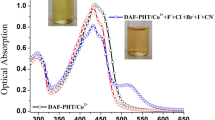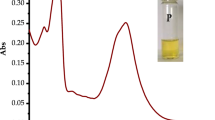Abstract
A new colorimetric chemosensor L, containing electron-donating moieties attached to the thiazole-based Schiff base was synthesized. The optical and colorimetric sensing properties of L for anions and cations were investigated using naked eye, UV–Vis and computational studies. The receptor L displays visual changes towards anions like F−, H2PO4 − and AcO− and also towards cation such as Zn2+ in DMSO. Other anions such as Cl −, Br−, I−, NO3 − and HSO4 − did not cause any color change. On the addition of other metal ions such as Cr3+, Mn2+, Fe3+, Co2+, Ni2+, Cu2+, Cd2+, Hg2+ and Pb2+, the receptor did not show any significant change. The binding constant (K a ) and stoichiometry of the host–guest complex formed were calculated by the Benesi–Hildebrand (B–H) plot and Job’s plot method, respectively. Computational studies and UV–Vis titration were further used to emphasize the sensing behavior of the receptor. Quantum chemical calculations and molecular studies using Density Functional Theory and Molecular Electrostatic Potential surface studies were carried out to supplement the experimental results and gain deeper insights about the structural as well as the spectral aspects of the complex.
Graphical Abstract
Receptor L proved to be a fluorescence and colorimetric Zn (II), fluoride (F−1), di-hydrogen phosphate (H2PO −14 ) and acetate (AcO−1) sensor. This new chromogenic receptor shows a highly selective coloration for the above ions. The chemosensor showed a color change upon addition of Zn (II), or fluoride or di-hydrogen phosphate or acetate ions.










Similar content being viewed by others
References
Arabahmadi R, Amani S (2013) Synthesis and studies of selective chemosensors for anions and cations by azo-containing salicylaldimine-based receptors. J Coord Chem 66(2):218–226
Arabahmadi R, Amani S (2014) A new fluoride ion colorimetric sensor based on azo–azomethine receptors. Supramol Chem 26(5–6):321–328
Arabahmadi R, Orojloo M, Amani S (2014) Azo Schiff bases as colorimetric and fluorescent sensors for recognition of F−, Cd2+ and Hg2+ ions. Anal Methods 6(18):7384–7393
Assaf S, Chung S-H (1984) Release of endogenous Zn2+ from brain tissue during activity. Nature 308(5961):734–736
Beer PD, Gale PA (2001) Anion recognition and sensing: the state of the art and future perspectives. Angew Chem Int Ed 40(3):486–516
Benesi HA, Hildebrand J (1949) A spectrophotometric investigation of the interaction of iodine with aromatic hydrocarbons. J Am Chem Soc 71(8):2703–2707
Berg JM, Shi Y (1996) The galvanization of biology: a growing appreciation for the roles of zinc. Science 271(5252):1081
Borisenko V et al (2006) Hydrogen bonds of 2-aminothiazoles in intermolecular complexes (1:1 and 1:2) with proton acceptors in solutions. J Mol Struct 783(1):101–115
Borisova NE, Reshetova MD, Ustynyuk YA (2007) Metal-free methods in the synthesis of macrocyclic Schiff bases. Chem Rev 107(1):46–79
Buccella D, Horowitz JA, Lippard SJ (2011) Understanding zinc quantification with existing and advanced ditopic fluorescent Zinpyr sensors. J Am Chem Soc 133(11):4101–4114
Burdette SC, Lippard SJ (2001) ICCC34—golden edition of coordination chemistry reviews. Coordination chemistry for the neurosciences. Coord Chem Rev 216:333–361
Burdette SC, Lippard SJ (2003) Meeting of the minds: metalloneurochemistry. Proc Natl Acad Sci 100(7):3605–3610
Canpolat E, Kaya M (2005) Studies on mononuclear chelates derived from substituted Schiff Base ligands: synthesis and characterization of a new 5-methoxysalicyliden-p-aminoacetophenoneoxime and its complexes with Co (II), Ni (II), Cu (II), and Zn (II). Russ J Coord Chem 31(11):790–794
Chohan ZH et al (2004) Isatin-derived antibacterial and antifungal compounds and their transition metal complexes. J Enzyme Inhib Med Chem 19(5):417–423
Cozzi PG (2004) Metal-Salen Schiff base complexes in catalysis: practical aspects. Chem Soc Rev 33(7):410–421
Falchuk KH (1998) The molecular basis for the role of zinc in developmental biology. In: Pierce GN, Izumi T, Rupp H, Grynberg A (eds) Molecular and cellular effects of nutrition on disease processes, vol 26. Springer, Boston
Frederickson CJ et al (2006) Synaptic release of zinc from brain slices: factors governing release, imaging, and accurate calculation of concentration. J Neurosci Methods 154(1):19–29
Frisch M et al (2004) Gaussian 03, revision C. 02. Gaussian, Inc., Wallingford, p 26
Gale PA, Garcia-Garrido SE, Garric J (2008) Anion receptors based on organic frameworks: highlights from 2005 and 2006. Chem Soc Rev 37(1):151–190
Gentili PL (2007) Boolean and fuzzy logic implemented at the molecular level. Chem Phys 336(1):64–73
Gunnlaugsson T et al (2006) Anion recognition and sensing in organic and aqueous media using luminescent and colorimetric sensors. Coord Chem Rev 250(23):3094–3117
Gupta VK et al (2013) Comparative study of colorimetric sensors based on newly synthesized Schiff bases. Sens Actuators B Chem 182:642–651
Hu R et al (2010) A rapid aqueous fluoride ion sensor with dual output modes. Angew Chem Int Ed 49(29):4915–4918
Jiang P, Guo Z (2004) Fluorescent detection of zinc in biological systems: recent development on the design of chemosensors and biosensors. Coord Chem Rev 248(1):205–229
Joseyphus RS, Dhanaraj CJ, Nair MS (2006) Synthesis and characterization of some Schiff base transition metal complexes derived from vanillin and L (+) alanine. Transition Met Chem 31(6):699–702
Kang SO et al (2010) Cryptand-like anion receptors. Chem Soc Rev 39(10):3980–4003
Lavigne JJ, Anslyn EV (2001) Sensing a paradigm shift in the field of molecular recognition: from selective to differential receptors. Angew Chem Int Ed 40(17):3118–3130
Lee MH et al (2010) A novel strategy to selectively detect Fe(III) in aqueous media driven by hydrolysis of a rhodamine 6G Schiff base. Chem Commun 46(9):1407–1409
Leung AC, MacLachlan MJ (2007) Poly (salphenyleneethynylene) s: soluble, conjugated metallopolymers that exhibit unique supramolecular crosslinking behavior. J Mater Chem 17(19):1923–1932
Li S-H et al (2009) Enhanced fluorescence sensing of hydroxylated organotins by a boronic acid-linked Schiff base. Chem Commun 28:4179–4181
Li N, Xiang Y, Tong A (2010) Highly sensitive and selective “turn-on” fluorescent chemodosimeter for Cu2+ in water via Cu2+-promoted hydrolysis of lactone moiety in coumarin. Chem Commun 46(19):3363–3365
Li H, Lalancette RA, Jäkle F (2011) Turn-on fluorescence response upon anion binding to dimesitylboryl-functionalized quaterthiophene. Chem Commun 47(33):9378–9380
Li J et al (2012) A highly selective and sensitive polymer-based OFF-ON fluorescent sensor for Hg2+ detection incorporating salen and perylenyl moieties. J Mater Chem 22(2):478–482
Li Y-P et al (2013) A new ditopic ratiometric receptor for detecting zinc and fluoride ions in living cells. Analyst 138(18):5486–5494
Li Y et al (2014) A bimodal multianalyte simple molecule chemosensor for Mg2+, Zn2+, and Co2+. Dalton Trans 43(4):1881–1887
Likussar W, Boltz D (1971) Theory of continuous variations plots and a new method for spectrophotometric determination of extraction and formation constants. Anal Chem 43(10):1265–1272
Lin H-Y et al (2012) A turn-on and reversible fluorescence sensor for zinc ion. Analyst 137(19):4415–4417
Liu A et al (2013) A novel rhodamine-based colorimetric and fluorescent sensor for the dual-channel detection of Cu 2+ and Fe 3+ in aqueous solutions. Dyes Pigm 99(2):472–479
Maret W et al (1999) Inhibitory sites in enzymes: zinc removal and reactivation by thionein. Proc Natl Acad Sci 96(5):1936–1940
Martinez-Manez R, Sancenón F (2003) Fluorogenic and chromogenic chemosensors and reagents for anions. Chem Rev 103(11):4419–4476
Martínez-Máñez R, Sancenón F (2006) Chemodosimeters and 3D inorganic functionalised hosts for the fluoro-chromogenic sensing of anions. Coord Chem Rev 250(23):3081–3093
Modi J, Sabnis S, Deliwala C (1970) Potential anticancer agents. III. Schiff bases from benzaldehyde nitrogen mustards and aminophenylthiazoles. J Med Chem 13(5):935–941
Momoki K et al (1969) Theory of curved molar ratio plots and a new linear plotting method. Anal Chem 41(10):1286–1299
Orojloo M, Amani S (2016) Synthesis and studies of selective chemosensor for naked-eye detection of anions and cations based on a new Schiff-base derivative. Talanta 159:292–299
Orojloo M, Amani S (2017) Naked-eye detection of cyanide ions in aqueous media based on an azo-azomethine chemosensor. C R Chim 20(4):415–423
Orojloo M et al (2017) Synthesis and characterization of cobalt (II), nickel (II), copper (II) and zinc (II) complexes derived from two Schiff base ligands: spectroscopic, thermal, magnetic moment, electrochemical and antimicrobial studies. Inorg Chim Acta 467:227–237
Park S et al (2012) Azo dye-based latent colorimetric chemodosimeter for the selective detection of cyanides in aqueous buffer. Sens Actuators B Chem 174:140–144
Prodi L, Montalti M, Zaccheroni N (2011) Luminescence applied in sensor science, vol 300. Springer Science & Business Media, New York
Safin DA, Babashkina MG, Garcia Y (2013) Crown ether-containing Schiff base as a highly efficient “turn-on” fluorescent sensor for determination and separation of Zn2+ in water. Dalton Trans 42(6):1969–1972
Santos-Figueroa LE et al (2013) Chromogenic and fluorogenic chemosensors and reagents for anions. A comprehensive review of the years 2010–2011. Chem Soc Rev 42(8):3489–3613
Sarkar K et al (2009) Selective zinc (II)-ion fluorescence sensing by a functionalized mesoporous material covalently grafted with a fluorescent chromophore and consequent biological applications. Adv Func Mater 19(2):223–234
Sessler JL, Seidel D (2003) Synthetic expanded porphyrin chemistry. Angew Chem Int Ed 42(42):5134–5175
Shang L, Jin L, Dong S (2009) Sensitive turn-on fluorescent detection of cyanide based on the dissolution of fluorophore functionalized gold nanoparticles. Chem Commun 21:3077–3079
Shen R et al (2008) Anion recognition by a novel zinc (Π) xanthone–crown ether complex. Inorg Chem Commun 11(3):318–322
Sheng R et al (2008) Colorimetric test kit for Cu2+ detection. Org Lett 10(21):5015–5018
Tomat E, Lippard SJ (2010) Ratiometric and intensity-based zinc sensors built on rhodol and rhodamine platforms. Inorg Chem 49(20):9113–9115
Vashi K, Naik H (2004) Synthesis of novel Schiff base and azetidinone derivatives and their antibacterial activity. J Chem 1(5):272–275
Venugopala K, Jayashree B (2003) Synthesis of carboxamides of 2′-amino-4′-(6-bromo-3-coumarinyl) thiazole as analgesic and antiinflammatory agents. Indian J Heterocycl Chem 12(4):307–310
Vigato P, Tamburini S, Bertolo L (2007) The development of compartmental macrocyclic Schiff bases and related polyamine derivatives. Coord Chem Rev 251(11):1311–1492
Wang Q-Q, Day VW, Bowman-James K (2011) Tunable, shape-shifting capsule for dicarboxylates. Chem Sci 2(9):1735–1738
Wang S et al (2015) A well-defined alternating copolymer based on a salicylaldimine Schiff base for highly sensitive zinc (II) detection and pH sensing in aqueous solution. Polym Chem 6(7):1127–1136
Xu Z et al (2009) Zn2+-triggered amide tautomerization produces a highly Zn2+-selective, cell-permeable, and ratiometric fluorescent sensor. J Am Chem Soc 132(2):601–610
Xue L et al (2012) Rational design of a ratiometric and targetable fluorescent probe for imaging lysosomal zinc ions. Inorg Chem 51(20):10842–10849
Yoon J et al (2006) Imidazolium receptors for the recognition of anions. Chem Soc Rev 35(4):355–360
Zalewski PD, Forbes IJ, Betts W (1993) Correlation of apoptosis with change in intracellular labile Zn (II) using zinquin [(2-methyl-8-p-toluenesulphonamido-6-quinolyloxy) acetic acid], a new specific fluorescent probe for Zn (II). Biochem J 296(2):403–408
Zyryanov GV, Palacios MA, Anzenbacher P (2007) Rational design of a fluorescence-turn-on sensor array for phosphates in blood serum. Angew Chem Int Ed 46(41):7849–7852
Acknowledgements
The authors (M. Orojloo and S. Amani) would like to thank the Research Council of Arak University for financial support of this research.
Author information
Authors and Affiliations
Corresponding author
Electronic supplementary material
Below is the link to the electronic supplementary material.
Rights and permissions
About this article
Cite this article
Orojloo, M., Arabahmadi, R., Naderi, F. et al. A novel receptor for detection of Zn2+ metal ion and F−, H2PO4 − and AcO− anions in aqueous media: a DFT study. Chem. Pap. 72, 719–729 (2018). https://doi.org/10.1007/s11696-017-0312-7
Received:
Accepted:
Published:
Issue Date:
DOI: https://doi.org/10.1007/s11696-017-0312-7




